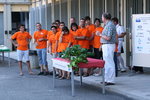Students’ submarines compete at NATO research centre event
Earlier this month, future engineers from across Europe put their submarines to the test at a competition organized by NATO’s Undersea Research Centre (NURC) in La Spezia, Italy. The event challenged students to design and build autonomous underwater vehicles (AUVs) capable of actual missions such as underwater demining and research.

The fifth Annual Student Autonomous Underwater Vehicle Challenge Europe (SAUC-E) stimulated innovation and technology, and encouraged young people to pursue careers in underwater technology and related fields.
“The SAUC-E competition is important not only to NURC, but also to NATO nations,” says the event’s organizer Lt Cdr Rob Cornick. The competition took place along the NURC waterfront, near the Ligurian Sea, where limited visibility tested the AUVs with a trying and realistic environment.
“The competition challenges faced by the students are very similar to some of the problems that our scientists are working on; autonomous systems are integral to the transformation of NATO’s future navies.”
Lt Cdr Cornick is the programme officer for NURC’s Autonomous Mine Countermeasures project. As a keen supporter of robotic technology, he works closely with scientific researchers to transform NATO’s mine warfare capability. “These students have an opportunity to test what they learn at their universities, and to meet with working engineers and scientists in the field,” he says.
“We hope that this experience will solidify their interest in science and engineering, especially for defence and security. This vision is shared by our competition sponsors, some of whom are defence research organizations.”
University of Girona team gets top prize
 This year’s first prize went to students from Spain’s University of Girona, beating out eight other teams from universities and institutes in France, Germany and the United Kingdom. A group from the UK’s Heriot-Watt University won second prize and third place went to a team from the French engineering school ENSIETA.
This year’s first prize went to students from Spain’s University of Girona, beating out eight other teams from universities and institutes in France, Germany and the United Kingdom. A group from the UK’s Heriot-Watt University won second prize and third place went to a team from the French engineering school ENSIETA.
“It has been a great experience,” says team captain Natalia Hurtós. “It was tough this year because we designed a completely new vehicle, a completely new software architecture, but we were able to come here with quite an operable vehicle.”
Each team made an oral presentation and provided a technical paper describing their vehicle’s design and their approach to the mission. They were judged on technical merit, performance of mission tasks, a journal, design safety, craftsmanship and innovation.
Ms Hurtós’ team had been working since January, putting all their time and effort into the project. The competition was a really good experience, she says, because each team member is working in this area, and finding applications for one’s work makes it worth all the effort.
Some of the boats had not been tested in a real harbour environment, with challenging conditions such as changing wave action and salinity. The teams therefore arrived on 28 June to put their vehicles through a series of practice runs in order to resolve last-minute technical problems and adjust mission plans and algorithms.
Long term investment
To build on the event’s momentum, NURC will host the SAUC-E competition for another three years, along with the recently launched Centre of Ocean Research and Advanced Learning in Liguria (CORALL).
Through this event, the centre seeks to provide students with “the opportunity to experience first-hand the challenges of underwater technologies, and to nurture interest in this area of research,” says Dr François-Régis Martin-Lauzer, NURC’s Director since 2006.
This year, while SAUC-E ’10 took place, La Spezia secondary school teachers learned about the Sea Perch Program, an innovative underwater robotics programme that trains students to build remotely operated vehicles. Run by the Massachusetts Institute of Technology’s Sea Grant since 2003, the programme aims to ignite students’ interest in science, technology and engineering.
Background
One of three research and technology organizations in NATO, NURC conducts undersea research to support NATO's operational and transformation requirements, helping to find solutions to maritime security problems.
“NURC is committed to raising the profile of maritime education and research among NATO nations,” says Lt Cdr Cornick.
The centre works under the oversight of Allied Command Transformation, which leads the transformation of NATO’s military structure, forces, capabilities and doctrine at the strategic command level. The transformation of NATO’s military capability into a leaner and more efficient force is one of the Alliance’s priorities for the years to come.
